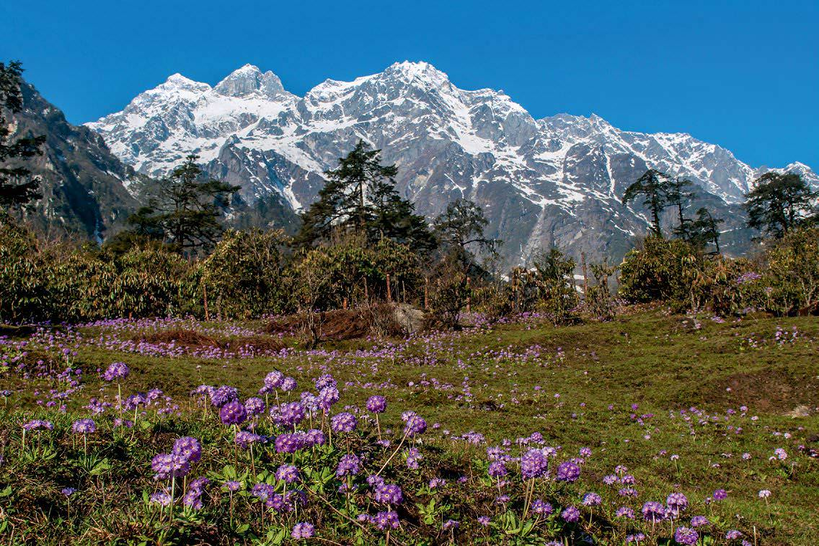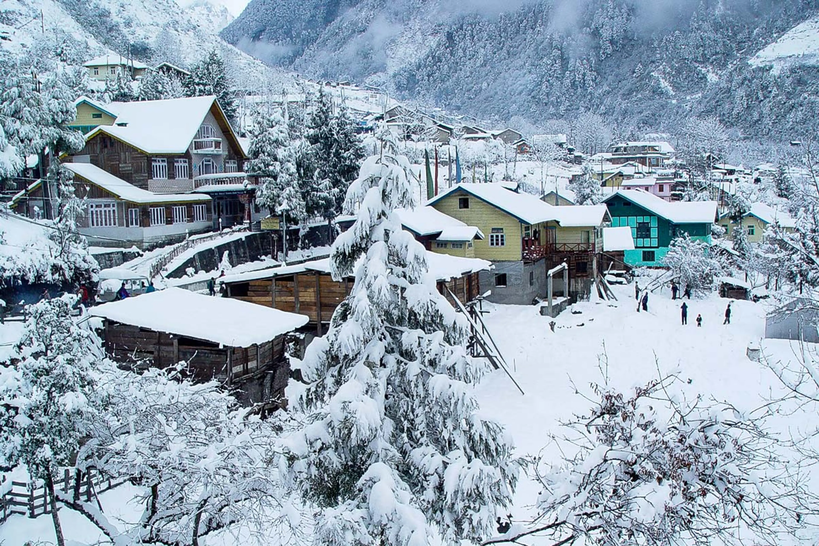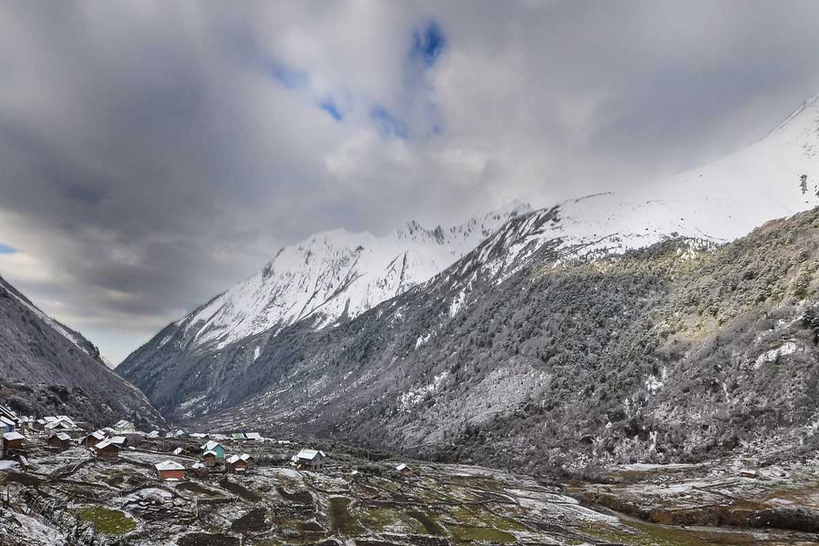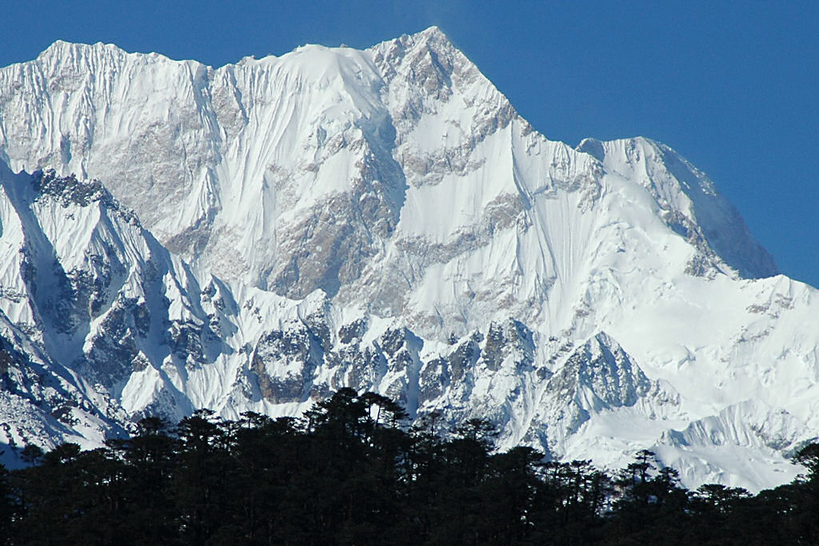Sikkim in Winter
Sikkim in winter becomes an amazing paradise that provides peaceful and attractive experiences for its visitors. Sikkim in winter is defined by cold temperatures and periodic snowfall at higher elevations and lasts from December to February. It’s a great time to explore without the crowds that usually gather during the warmer months because of the cool, clean weather experienced in the capital city, Gangtok, and other lower-altitude regions. The gorgeous scenery is set against an amazing scenery of snow-capped Himalayan peaks when the skies are clear. Even though it’s cold, tourists can see frozen lakes and perfect snow-covered landscapes at well-known locations like Tsomgo Lake and Nathula Pass. If you want to know how to reach Sikkim from any location in India, you can travel by car, train, or air to get to Sikkim. Despite being landlocked by its sister states in the northeast, Sikkim’s increased connectivity with the rest of the nation has drawn a large number of tourists there each year.
Why Should You Visit Sikkim In Winter?
Winter travel to Sikkim is a unique and satisfying experience that reveals the state’s built-in charm in a new way. Located in the eastern Himalayas, Sikkim provides a calm and peaceful environment in the winter months. The magical beauty of the landscape is enhanced by the cool mountain air and snow-capped peaks. In winter you can enjoy lots of activities in Sikkim. Visitors may be able to access the well-known Nathula Pass, which is typically closed during periods of severe snowfall and offers stunning views of the snow-covered mountains and the Indo-China border. The capital city, Gangtok, is a great place for a quiet holiday because it has a warm, inviting atmosphere in the winter months thanks to its festive light display. The sight of snow-covered hills surrounding the frozen Tsomgo Lake is captivating.
Weather In Sikkim During Winter
Temperature: The daytime temperatures in Sikkim typically range from 5 to 15 degrees Celsius during the winter, when the state experiences cool to extremely cold temperatures.
Snowfall: Periodic snowfall at higher elevations can turn the weather into a snow-covered, pristine area.
Clear Skies: Winter brings with it a clear sky that accentuates the overall scenic beauty and provides stunning views of the snow-capped Himalayan peaks.
Adventure Opportunities: Lower elevations allow for winter trekking, making it appealing to travelers looking to explore the region’s diverse environment.
Cultural Festivals: Sikkim in winter hosts a variety of cultural festivals that allow visitors to involve themselves in local traditions and celebrations.
Pack Warm Clothes: Travelers should pack appropriately, including heavy jackets, gloves, and insulated footwear, especially if they plan to visit higher altitudes.
Top Places to visit in Sikkim in Winter
1. Yumthang Valley of Flowers

Yumthang Valley is considered one of the best places to visit in Sikkim because of its rolling fields, yaks that graze by the banks of the wild Teesta River, and its numerous hot springs surrounded by rising mountain peaks. About 128 kilometers from Gangtok, at an elevation of more than 11,000 feet above sea level, is covered with flowers. To ensure you don’t miss out on the greatest of Gangtok, you can reserve one of our Gangtok Tours from a vibrant selection of packages we have available.
If you want to know the best time to visit, visit the valley between late February and early March, when the residents celebrate the Losar festival. The Rhododendrons bloom and cover the valley in full glory in April and June.
2. Lachung

At 9,610 feet in elevation, the little town of Lachung, North Sikkim, twinkles like a morning star. Lachung is located 103 kilometers away from Gangtok. The river Teesta will wind beside you as you travel from Gangtok. A visit to the renowned Zero Point and Lachung Monastery would be incomplete if one were to visit the Lachung hamlet without doing so. The best time to visit Lachung in Sikkim is from April to June and September to November.
3. Thangu

Situated at an amazing elevation of 3,962 meters, the captivating Thangu Valley is blanketed in a thick layer of snow for nearly the whole year. The entire area is blanketed in beautiful mountain flora in May and June. The well-known Chopta Valley and Muguthang trek both start and end in Thangu. With an abundance of mind-blowing views to captivate your senses, the valley is highlighted by the rivers Teesta, Chopta, and Lassur. The quiet village of Thangu is located far from the bustle of towns and cities, surrounded by majestic Himalayan massifs. It takes six or seven hours to drive scenically from Gangtok to the valley.
4. Zemu Glacier

The eastern starting point for climbing Kanchenjunga, the third-highest peak in the world, is Zemu Glacier. This glacier, which stretches 26 kilometers, is an essential source of water for the Teesta River in the Himalayas. You travel by road from Gangtok to Lachen in North Sikkim and then proceed on foot to Jakthang.If you are planing to visit Zemu Glacier, winter is best time to visit.
At an elevation of approximately 16,000 feet above sea level, Green Lake is a significant landmark where most hikers finish and head back. However, continuing forward, passing through Yabuk and Rimbik, will bring you to the snow-covered 18,648-foot-high Zemu Glacier. From here, you can see the splendor of Mount Siniolchu and other Himalayan peaks in all their beauty.
Travel tips for Sikkim in Winter
Carry Warm Clothes: Sikkim in winter can be cold, particularly at higher elevations. To keep warm, bring along heavy jackets, thermal clothes, gloves, and insulated shoes.
Check Weather Forecast: To stay informed about any sudden changes and make appropriate plans, pay close attention to the weather forecast both before and during your trip.
Altitude considerations: Be ready for colder weather and the chance of snowfall when visiting higher altitudes such as Nathula Pass. Wear suitable clothing and adjust gradually.
Visit Open Attractions: Although there may be seasonal closures in some places, many attractions, such as Tsomgo Lake and Pelling, are open and offer stunning winter scenery.
Cultural Events: Before you travel, find out what festivals and other events are taking place in the area. Sikkim’s rich cultural heritage is showcased through unique celebrations held in the winter months.
Book Accommodations in Advance: Even though winter is a less busy season, it’s still a good idea to reserve lodging in advance, particularly in well-known tourist destinations.
Remain Hydrated: It’s important to stay hydrated even in the winter. It’s important to stay hydrated during the dry winter months, so drink lots of water.
Make a Trekking Plan: Winter trekking is possible at lower elevations. Determine your trekking routes ahead of time, taking the weather and your level of physical fitness into account. This is the best things to do in Sikkim.
Respect Local customs: Pay attention to the traditions and customs of the area. Winter is a great time to interact with the local community because it often falls around the festival season.
Conclusion
In conclusion, travelers looking for a mix of natural beauty and rich culture will find Sikkim during the winter months to offer a singular and peaceful experience. Visitors can enjoy the region’s stunning scenery and festivities if they make the proper preparations, which include packing warm clothing, keeping track of the weather, and honoring local customs. Winter offers the chance to take advantage of open-air attractions, go winter trekking, and attend regional cultural events. Wintertime in Sikkim offers a peaceful atmosphere, fewer tourists, and breathtaking scenery, so enjoy it while keeping an eye out for altitude issues and possible road closures. All things considered, visiting Sikkim in the winter offers a tranquil and unforgettable getaway into the heart of the Himalayas.
People also ask about Sikkim in Winter
1. What kind of winter weather can one expect in Sikkim?
The average temperature during Sikkim’s winter is 0°C (32°F) to 15°C (59°F), with severe weather being experienced. It may be below freezing at the higher elevations.
2. When is Sikkim's winter season beginning and ending?
November to February is when Sikkim’s winter season normally starts. January and December are the coldest months.
3. Is winter an ideal time to visit Sikkim?
For individuals who appreciate snow and cold temperatures, it might be a pleasant time. However, snowfall may make some places more difficult to access. Checking the state of the roads and making plans appropriately are crucial.
4. Where in Sikkim are the best places to go in the winter?
Popular winter destinations include Yumthang Valley, Nathula Pass, Tsomgo Lake, and Gangtok. These locations might provide beautiful scenes covered in snow.
5. Does Sikkim host any festivals or events in the winter?
Depending on the lunar calendar, Losar, the Tibetan New Year, is observed in either January or February. It’s a colorful celebration with customs and cultural activities.
6. Is it possible to see snow in Sikkim in the winter?
Yes, particularly in places with higher elevations like Nathula and Tsomgo Lake. Though snowfall can produce breathtaking scenery, it’s important to be ready for the cold conditions.
